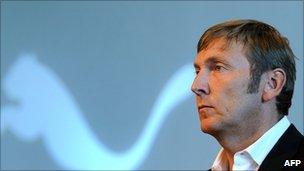Puma completes environmental impact costs
- Published

Executive chairman Jochen Zeitz says the Earth's natural resources can no longer be taken for granted
Sportswear firm Puma says it has become the first major corporation to fully cost its impact on the environment.
The German-based company has costed its greenhouse gas emissions, water and land use, air pollution and waste in 2010 at 145m euros ($196m; £124m).
This includes the activities of Puma itself and those of its suppliers.
The company's owner, PPR, said it would cost the environmental impact of all its luxury, sports and lifestyle brands, which include Gucci, by 2015.
'Nature's services'
In May this year Puma announced that the combined cost of the carbon it emitted and the water it used last year was 94.4m euros.
It has now added the cost of land use change for raw material production, air pollution and waste.
Overall, the company said its supply chain was responsible for 94% of its environmental costs. Over half were associated with the production of raw materials.
"The unprecedented Puma environmental profit and loss account has been indispensable for us to realise the immense value of nature's services that are currently being taken for granted but without which companies could not sustain themselves," said executive chairman Jochen Zeitz.
Puma enlisted the help of consultancy firm PricewaterhouseCoopers (PwC) and environmental research group Trucost to calculate the impact of its business on nature.
Environmental accounting
An increasing number of companies are looking to put a value on their environmental impact with a view to incorporating these costs into their annual accounts.
Driving this move is the idea that the services and resources nature provides, such as flood protection by forests and genetic resources from plants used for live-saving drugs, are not infinite, and therefore should no longer be considered as free.
As these resources become ever-more scarce, businesses will have to pay to protect them or, in some cases, replace them.
Those companies that are taking action to reduce their environmental impact now, and therefore their associated costs, believe they can gain a competitive advantage over their rivals.
- Published16 May 2011
- Published12 October 2010
- Published21 October 2010